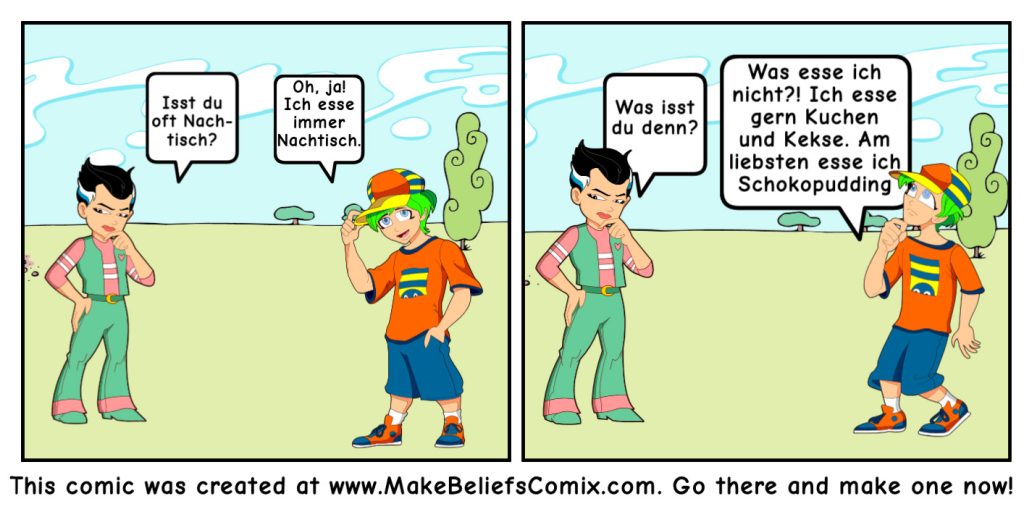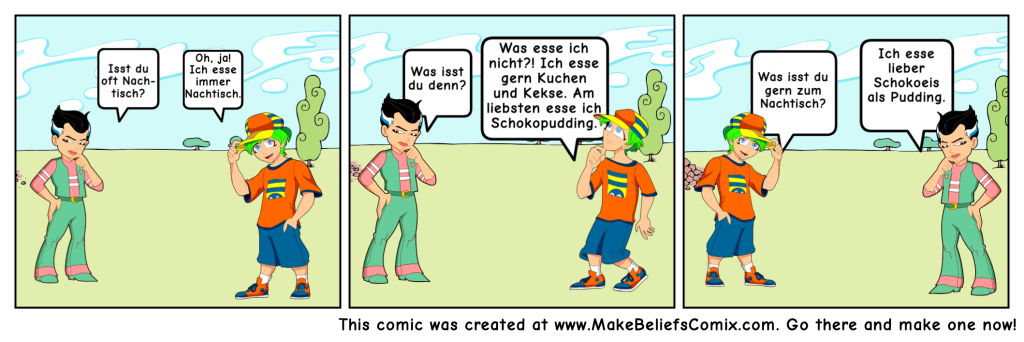6.9 Um den Pudding gehen

Guten Tag!
Zum Aufwärmen machen wir unseren Tagesminiplausch und eine Wiederholung.
Wiederholung
In the previous lesson, you learned how to talk more about the warme Mahlzeit by talking about the frequency with which you consume some typical foods, asking others about their preferences, and talking about your preferences. Let’s review what you have learned.
Wann und wie oft isst du warm? Was isst du gerne? Was isst du am liebsten? Answer the questions in your written journal. Then record in your audio journal.
Lektionsüberblick
At the end of a large meal, you may want to go for a walk (which is called a Verdauungsspaziergang = a digestive walk). If you are in Northern Germany, someone may prompt such a walk by saying “Laß uns um den Pudding gehen” (=to walk around the pudding). This lesson will focus on the pudding you eat for Nachtisch (dessert), which is generally served after the warme Mahlzeit. In the end, you will be able to 1) talk about how often you have Nachtisch (dessert), 2) ask others about their Nachtisch preferences, and 3) talk about your Nachtisch preferences.
Was weißt du schon?
| Noch nicht start klar?
Du kannst immer auf die gleiche 1010-Lektion zurückgreifen! |
Not confident about starting this lesson?
You can always review the same Lektion from 1010. |
1) Wie oft isst du Nachtisch?
Do you remember what words you need to talk about how often you do something? Let’s check!
Now let’s look at the different ways we can talk about how often we eat dessert:
Ich esse immer etwas zum Nachtisch.
Ich esse manchmal Nachtisch.
Ich esse keinen Nachtisch.
Jetzt bist du dran!
Hamburg im Blickpunkt

Die Elbphilharmonie (umgangssprachlich Elphi) ist ein im Januar 2017 eröffnetes Konzerthaus in Hamburg. Sie wurde mit dem Ziel geplant, ein neues Wahrzeichen der Stadt und ein „Kulturdenkmal für alle“ zu schaffen. Das 110 Meter hohe Gebäude liegt im Stadtteil HafenCity. Es wurde unter Einbeziehung der Hülle des früheren Kaispeichers A (Baujahr 1963) errichtet. Auf diesen Sockel wurde ein moderner Aufbau mit einer Glasfassade gesetzt, die an Segel, Wasserwellen, Eisberge oder einen Quarzkristall erinnern soll. Die Elbphilharmonie ist das höchste bewohnte Gebäude Hamburg.
The Elbphilharmonie (popularly nicknamed Elphi) is a concert hall in Hamburg opened in January 2017. It was developed with the plan to create a new landmark for the city and a “cultural monument for everyone”. The building is located in the HafenCity quarter of Hamburg and is 110m (354 ft) high. The new construction rests on top of an old brick warehouse (Kaispeicher A, built in 1963). The modern addition of glass resembles a hoisted sail, water waves, an iceberg or a quartz crystal. It is the tallest inhabited building in Hamburg.
2) Was isst du zum Nachtisch?
If someone eats dessert with any regularity (anything more than never), then it can make sense to ask what they eat for dessert. Let’s look at how such a conversation might happen.
 |
You can always ask “Was isst du zum Nachtisch?” but if you’ve already asked “Isst du Nachtisch?” it can sound a bit strange to repeat the words for dessert. You can also ask “Was isst du gern?”
Jetzt bist du dran!
3) Ich esse lieber … zum Nachtisch.
To talk about our dessert preferences, we need to remember the various words for kinds of desserts and the words for comparison and preference. Let’s first review the words for desserts:
Now let’s look at talking about dessert preferences.
 |
Now let’s practice.
Jetzt bist du dran!
Zum Schluß

*As you conclude this lesson, don’t forget to check Canvas!*

Media Attributions
- 1020-banner-large-reduced
- 6.9 was isst du make-beliefs-comix © This comic strip was generated at http://www.MakeBeliefsComix.com. Used by permission of author and site creator Bill Zimmerman.
- 6.9 was isst du erweitertes gespraech make-beliefs-comix(1) © This comic strip was generated at http://www.MakeBeliefsComix.com. Used by permission of author and site creator Bill Zimmerman.

